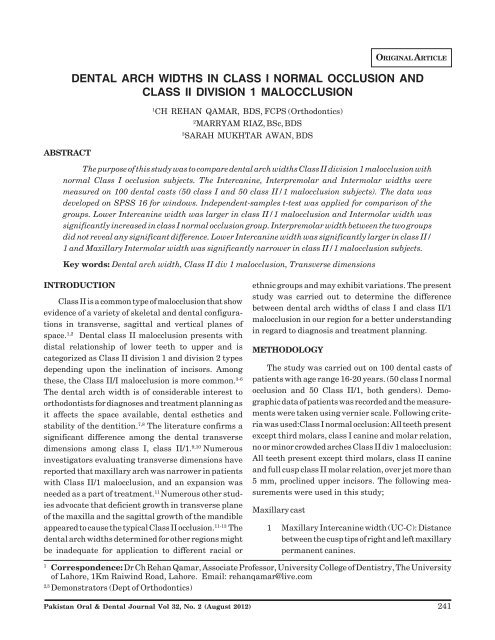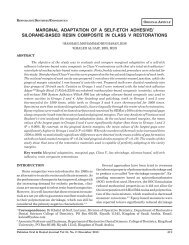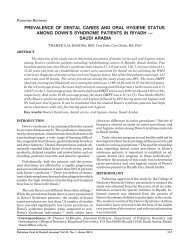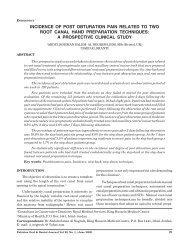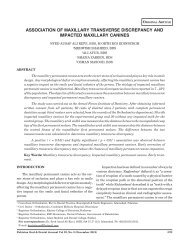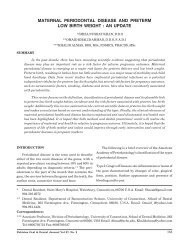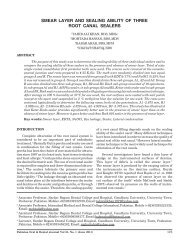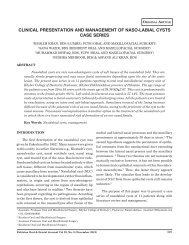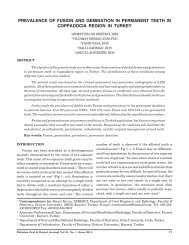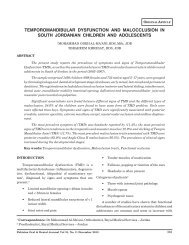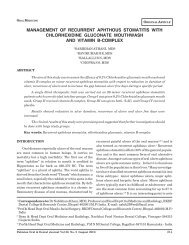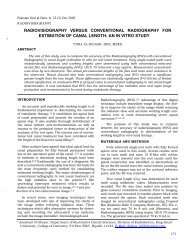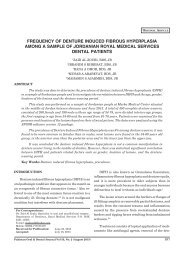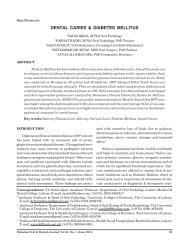dental arch widths in class i normal occlusion and class ii division 1 ...
dental arch widths in class i normal occlusion and class ii division 1 ...
dental arch widths in class i normal occlusion and class ii division 1 ...
You also want an ePaper? Increase the reach of your titles
YUMPU automatically turns print PDFs into web optimized ePapers that Google loves.
Dental <strong>arch</strong> <strong>widths</strong> <strong>in</strong> <strong>normal</strong> <strong>and</strong> <strong>in</strong> mal<strong>occlusion</strong><br />
ABSTRACT<br />
ORIGINAL ARTICLE<br />
DENTAL ARCH WIDTHS IN CLASS I NORMAL OCCLUSION AND<br />
CLASS II DIVISION 1 MALOCCLUSION<br />
1<br />
CH REHAN QAMAR, BDS, FCPS (Orthodontics)<br />
2<br />
MARRYAM RIAZ, BSc, BDS<br />
3<br />
SARAH MUKHTAR AWAN, BDS<br />
The purpose of this study was to compare <strong>dental</strong> <strong>arch</strong> <strong>widths</strong> Class II <strong>division</strong> 1 mal<strong>occlusion</strong> with<br />
<strong>normal</strong> Class I <strong>occlusion</strong> subjects. The Intercan<strong>in</strong>e, Interpremolar <strong>and</strong> Intermolar <strong>widths</strong> were<br />
measured on 100 <strong>dental</strong> casts (50 <strong>class</strong> I <strong>and</strong> 50 <strong>class</strong> II/1 mal<strong>occlusion</strong> subjects). The data was<br />
developed on SPSS 16 for w<strong>in</strong>dows. Independent-samples t-test was applied for comparison of the<br />
groups. Lower Intercan<strong>in</strong>e width was larger <strong>in</strong> <strong>class</strong> II/1 mal<strong>occlusion</strong> <strong>and</strong> Intermolar width was<br />
significantly <strong>in</strong>creased <strong>in</strong> <strong>class</strong> I <strong>normal</strong> <strong>occlusion</strong> group. Interpremolar width between the two groups<br />
did not reveal any significant difference. Lower Intercan<strong>in</strong>e width was significantly larger <strong>in</strong> <strong>class</strong> II/<br />
1 <strong>and</strong> Maxillary Intermolar width was significantly narrower <strong>in</strong> <strong>class</strong> II/1 mal<strong>occlusion</strong> subjects.<br />
Key words: Dental <strong>arch</strong> width, Class II div 1 mal<strong>occlusion</strong>, Transverse dimensions<br />
INTRODUCTION<br />
Class II is a common type of mal<strong>occlusion</strong> that show<br />
evidence of a variety of skeletal <strong>and</strong> <strong>dental</strong> configurations<br />
<strong>in</strong> transverse, sagittal <strong>and</strong> vertical planes of<br />
space. 1,2 Dental <strong>class</strong> II mal<strong>occlusion</strong> presents with<br />
distal relationship of lower teeth to upper <strong>and</strong> is<br />
categorized as Class II <strong>division</strong> 1 <strong>and</strong> <strong>division</strong> 2 types<br />
depend<strong>in</strong>g upon the <strong>in</strong>cl<strong>in</strong>ation of <strong>in</strong>cisors. Among<br />
these, the Class II/I mal<strong>occlusion</strong> is more common. 3-6<br />
The <strong>dental</strong> <strong>arch</strong> width is of considerable <strong>in</strong>terest to<br />
orthodontists for diagnoses <strong>and</strong> treatment plann<strong>in</strong>g as<br />
it affects the space available, <strong>dental</strong> esthetics <strong>and</strong><br />
stability of the dentition. 7,8 The literature confirms a<br />
significant difference among the <strong>dental</strong> transverse<br />
dimensions among <strong>class</strong> I, <strong>class</strong> II/1. 9,10 Numerous<br />
<strong>in</strong>vestigators evaluat<strong>in</strong>g transverse dimensions have<br />
reported that maxillary <strong>arch</strong> was narrower <strong>in</strong> patients<br />
with Class II/1 mal<strong>occlusion</strong>, <strong>and</strong> an expansion was<br />
needed as a part of treatment. 11 Numerous other studies<br />
advocate that deficient growth <strong>in</strong> transverse plane<br />
of the maxilla <strong>and</strong> the sagittal growth of the m<strong>and</strong>ible<br />
appeared to cause the typical Class II <strong>occlusion</strong>. 11-13 The<br />
<strong>dental</strong> <strong>arch</strong> <strong>widths</strong> determ<strong>in</strong>ed for other regions might<br />
be <strong>in</strong>adequate for application to different racial or<br />
ethnic groups <strong>and</strong> may exhibit variations. The present<br />
study was carried out to determ<strong>in</strong>e the difference<br />
between <strong>dental</strong> <strong>arch</strong> <strong>widths</strong> of <strong>class</strong> I <strong>and</strong> <strong>class</strong> II/1<br />
mal<strong>occlusion</strong> <strong>in</strong> our region for a better underst<strong>and</strong><strong>in</strong>g<br />
<strong>in</strong> regard to diagnosis <strong>and</strong> treatment plann<strong>in</strong>g.<br />
METHODOLOGY<br />
The study was carried out on 100 <strong>dental</strong> casts of<br />
patients with age range 16-20 years. (50 <strong>class</strong> I <strong>normal</strong><br />
<strong>occlusion</strong> <strong>and</strong> 50 Class II/1, both genders). Demographic<br />
data of patients was recorded <strong>and</strong> the measurements<br />
were taken us<strong>in</strong>g vernier scale. Follow<strong>in</strong>g criteria<br />
was used:Class I <strong>normal</strong> <strong>occlusion</strong>: All teeth present<br />
except third molars, <strong>class</strong> I can<strong>in</strong>e <strong>and</strong> molar relation,<br />
no or m<strong>in</strong>or crowded <strong>arch</strong>es Class II div 1 mal<strong>occlusion</strong>:<br />
All teeth present except third molars, <strong>class</strong> II can<strong>in</strong>e<br />
<strong>and</strong> full cusp <strong>class</strong> II molar relation, over jet more than<br />
5 mm, procl<strong>in</strong>ed upper <strong>in</strong>cisors. The follow<strong>in</strong>g measurements<br />
were used <strong>in</strong> this study;<br />
Maxillary cast<br />
1 Maxillary Intercan<strong>in</strong>e width (UC-C): Distance<br />
between the cusp tips of right <strong>and</strong> left maxillary<br />
permanent can<strong>in</strong>es.<br />
1<br />
Correspondence: Dr Ch Rehan Qamar, Associate Professor, University College of Dentistry, The University<br />
of Lahore, 1Km Raiw<strong>in</strong>d Road, Lahore. Email: rehanqamar@live.com<br />
2,3<br />
Demonstrators (Dept of Orthodontics)<br />
Pakistan Oral & Dental Journal Vol 32, No. 2 (August 2012)<br />
241
Dental <strong>arch</strong> <strong>widths</strong> <strong>in</strong> <strong>normal</strong> <strong>and</strong> <strong>in</strong> mal<strong>occlusion</strong><br />
2 Maxillary Interpremolar width (UP-P): Distance<br />
between buccal cusp tips of right <strong>and</strong> left<br />
maxillary permanent first premolars.<br />
3 Maxillary Intermolar width (UM-M): Distance<br />
between the mesiobuccal cusp tips of<br />
right <strong>and</strong> left maxillary permanent first molars.<br />
M<strong>and</strong>ibular cast<br />
1 M<strong>and</strong>ibular Intercan<strong>in</strong>e width (LC-C): Distance<br />
between the cusp tips of right <strong>and</strong> left m<strong>and</strong>ibular<br />
permanent can<strong>in</strong>es.<br />
2 M<strong>and</strong>ibular Interpremolar width (LP-P): Distance<br />
between buccal cusp tips of right <strong>and</strong> left<br />
m<strong>and</strong>ibular permanent first premolars.<br />
3 M<strong>and</strong>ibular Intermolar width (LM-M): Distance<br />
between the mesiobuccal cusp tips of right <strong>and</strong><br />
left m<strong>and</strong>ibular permanent first molars.<br />
STATISTICAL ANALYSIS<br />
The mean <strong>and</strong> st<strong>and</strong>ard deviation for each parameter<br />
was calculated us<strong>in</strong>g the SPSS Version 16 for<br />
W<strong>in</strong>dows. Class 1 <strong>and</strong> Class II/1 measurements were<br />
compared us<strong>in</strong>g <strong>in</strong>dependent t-test. 50 casts were<br />
r<strong>and</strong>omly selected <strong>and</strong> remeasured after one week of<br />
first measurement <strong>and</strong> was compared to f<strong>in</strong>d out any<br />
method error by apply<strong>in</strong>g paired t-test.<br />
RESULTS<br />
There was no statistically significant difference<br />
documented between the first <strong>and</strong> the second measurements.<br />
TABLE 1: COMPARISON OF DENTAL<br />
ARCH WIDTHS<br />
Parameter Class I (n=50) Class II/1 (n=50)<br />
Mean Value Mean Value<br />
(mm)<br />
(mm)<br />
UC-C 34.2 ± 1.3 34.1 ± 2.1<br />
UP-P 40.3 ±1.9 39.9 ± 2<br />
UM-M 52.3 ± 1.8 50.1 ± 2.4*<br />
LC-C 26.3 ± 2 28.3 ± 2.3*<br />
LP-P 33.9 ± 1.3 34.3 ± 2.5<br />
LM-M 44.1 ± 2.3 44.5 ± 2.5<br />
* Significant value (p < .05)<br />
No significant difference was found for the mean<br />
values of maxillary Intercan<strong>in</strong>e width <strong>in</strong> <strong>class</strong> I (34.2 ±<br />
1.3) <strong>and</strong> ClassII/1 (34.1 ± 2.1) patients, while the<br />
m<strong>and</strong>ibular Intercan<strong>in</strong>e width was significantly larger<br />
<strong>in</strong> <strong>class</strong> II/1 (26.3 ± 2) than Class I subjects (28.3 ± 2).<br />
The mean value of Maxillary <strong>and</strong> m<strong>and</strong>ibular Interpremolar<br />
<strong>widths</strong> was found out to be 40.3 ±1.9 <strong>and</strong> 33.9<br />
± 1.3 for Class I whereas <strong>in</strong> <strong>class</strong> II/1 subjects it was 39.9<br />
± 2.1 <strong>and</strong> 34.3 ± 2.5 respectively, thus <strong>in</strong>dicat<strong>in</strong>g no<br />
significant difference between both the groups.<br />
The maxillary Intermolar width mean value for<br />
<strong>class</strong> I subjects (52.3 ± 1.8) was found out to be significantly<br />
larger as compared to <strong>class</strong> II/1 (50.1 ± 2.4).<br />
However, no statistically significant difference was<br />
demonstrated between the m<strong>and</strong>ibular Intermolar<br />
width <strong>in</strong> <strong>class</strong> I <strong>and</strong> <strong>class</strong> II/1 groups (44.1 ± 2.3 <strong>and</strong> 44.5<br />
± 2.5) respectively.<br />
DISCUSSION<br />
The current study was carried out to compare the<br />
<strong>dental</strong> <strong>arch</strong> <strong>widths</strong> <strong>in</strong> <strong>normal</strong> Class I <strong>occlusion</strong> with<br />
Class II/1 mal<strong>occlusion</strong> patients. The mean age of the<br />
study sample was 18.54±2.3 years. The literature<br />
reveals that most common causes of narrow maxillary<br />
<strong>arch</strong>es for <strong>class</strong> II/1 mouth breath<strong>in</strong>g, digit suck<strong>in</strong>g<br />
habits, tongue thrust<strong>in</strong>g. 14,15<br />
The results of current study <strong>in</strong>dicated no significant<br />
difference between the upper Intercan<strong>in</strong>e <strong>dental</strong><br />
<strong>arch</strong> <strong>widths</strong> among the two groups. However, the lower<br />
Intercan<strong>in</strong>e width was significantly larger <strong>in</strong> <strong>class</strong> II/1<br />
mal<strong>occlusion</strong> as compared to <strong>class</strong> I <strong>occlusion</strong>. These<br />
results were similar to Say<strong>in</strong> 7 <strong>and</strong> Tancun Usyal 8 study<br />
whereas was <strong>in</strong> contrary to study carried out by Staley<br />
et al 15 who stated that maxillary Intercan<strong>in</strong>e width was<br />
narrower <strong>in</strong> <strong>class</strong> II/1 than <strong>class</strong> I. No difference was<br />
found out <strong>in</strong> their study regard<strong>in</strong>g lower Intercan<strong>in</strong>e<br />
width between the tow groups. Bishara 17 however found<br />
no significant difference <strong>in</strong> Intercan<strong>in</strong>e <strong>widths</strong> between<br />
<strong>class</strong> I <strong>and</strong> <strong>class</strong> 11/1 mal<strong>occlusion</strong> group.<br />
The present study revealed no statically significant<br />
difference <strong>in</strong> Interpremolar width of both <strong>class</strong> I <strong>and</strong><br />
Class II/1 group <strong>in</strong> both the <strong>arch</strong>es. This was similar to<br />
the results obta<strong>in</strong>ed <strong>in</strong> previous studies. 7,8,16-19<br />
The current study revealed that maxillary<br />
Intermolar width was significantly larger <strong>in</strong> <strong>class</strong> 1<br />
<strong>occlusion</strong> as compared to <strong>class</strong> II/1 mal<strong>occlusion</strong>. This<br />
Pakistan Oral & Dental Journal Vol 32, No. 2 (August 2012)<br />
242
Dental <strong>arch</strong> <strong>widths</strong> <strong>in</strong> <strong>normal</strong> <strong>and</strong> <strong>in</strong> mal<strong>occlusion</strong><br />
was <strong>in</strong> agreement to previous studies conducted by<br />
Say<strong>in</strong> 7 , Staley 16 , Tallaro 18 <strong>and</strong> Buschang. 19 The results<br />
of <strong>in</strong>vestigations carried out by Tancan 8 were contrary<br />
to our study, where upper <strong>and</strong> lower Intermolar width<br />
was greater <strong>in</strong> <strong>class</strong> II/1. Another study conducted by<br />
Frohlich 20 found no difference <strong>in</strong> Intermolar <strong>widths</strong><br />
between <strong>class</strong> I <strong>and</strong> <strong>class</strong> II/1 mal<strong>occlusion</strong> groups.<br />
CONCLUSION<br />
1 Lower Intercan<strong>in</strong>e width is significantly larger<br />
<strong>in</strong> <strong>class</strong> II/1.<br />
2 Maxillary Intermolar width is significantly narrower<br />
<strong>in</strong> <strong>class</strong> II/1 as compared to <strong>class</strong> I<br />
<strong>normal</strong> <strong>occlusion</strong> patients. Therefore, maxillary<br />
transverse discrepancy suggests itself due<br />
to maxillary posterior teeth rather than the<br />
lower posterior teeth.<br />
REFERENCES<br />
1 Rehan Q, Naseer Ch. Cephalometric characteristics of <strong>class</strong><br />
II mal<strong>occlusion</strong>: Gender Dimorphism. Pak Oral Dental J<br />
2007;27:73-78.<br />
2 Abida A, Amjad N, Hameedullah J. Prevalence of <strong>class</strong> II<br />
mal<strong>occlusion</strong>s <strong>in</strong> Pakistani sample. Pak Oral Dental J 2010;<br />
3:96-100.<br />
3 Firdos T. Investigation of <strong>class</strong> II mal<strong>occlusion</strong>-A study conducted<br />
at Khyber College of Dentistry, Peshawar-Pakistan.<br />
Pak Oral Dental J 2000;20:158-64.<br />
4 Emmad A, Al-Khateeb A, Susan N, Al-Khateeb. Antero<br />
posterior <strong>and</strong> Vertical Components of Class II <strong>division</strong> 1 <strong>and</strong><br />
<strong>division</strong> 2 Mal<strong>occlusion</strong>. Angle Orthod 2009;79:859-66.<br />
5 Rehan Q, Nadia R, Sadia L. Cephalometric characteristics of<br />
<strong>class</strong> II <strong>division</strong> 1 <strong>and</strong> Class II <strong>division</strong> 2 mal<strong>occlusion</strong>. Pak Oral<br />
Dental J 2010;30:138-41.<br />
6 John Y, L<strong>in</strong>g K, Wong R. Dental Arch Widths of Southern<br />
Ch<strong>in</strong>ese. Angle Orthod 2009;79:54-63.<br />
7 Say<strong>in</strong> MO, Turkkahraman H. Comparison of Dental Arch <strong>and</strong><br />
Alveolar Widths of Patients with Class II, Division 1 Mal<strong>occlusion</strong><br />
<strong>and</strong> Subjects with Class I Ideal Occlusion. Angle Orthod<br />
2004;74:356-60.<br />
8 Tancan U, Serdar U, Badel M, Zafer S. Dental <strong>and</strong> Alveolar<br />
Arch Widths <strong>in</strong> Normal Occlusion <strong>and</strong> Class III Mal<strong>occlusion</strong>.<br />
Angle Orthod 2005;75:941-47.<br />
9 Baccetti, Franchi TL, McNamara Jr JA, Tollaro I. Early<br />
dentofacial features of Class II mal<strong>occlusion</strong>: a longitud<strong>in</strong>al<br />
study from the deciduous through the mixed dentition. Am J<br />
Orthod Dentofacial Orthop 1997;11:502–9.<br />
10 Lux CJ, Conradt C, Burden D, Komposch G. Dental <strong>arch</strong><br />
<strong>widths</strong> <strong>and</strong> m<strong>and</strong>ibular-maxillary base <strong>widths</strong> <strong>in</strong> Class II<br />
mal<strong>occlusion</strong>s between early mixed <strong>and</strong> permanent dentitions.<br />
Angle Orthod 2003;73:674–85.<br />
11 Baccetti, Franchi TL, McNamara Jr JA, Tollaro I. Early<br />
dentofacial features of Class II mal<strong>occlusion</strong>: a longitud<strong>in</strong>al<br />
study from the deciduous through the mixed dentition. Am J<br />
Orthod Dentofacial Orthop 1997;11:502–9.<br />
12 McNamara Jr. J. A. Early <strong>in</strong>tervention <strong>in</strong> the transverse<br />
dimension: is it worth the effort? Am J Orthod Dentofacial<br />
Orthop 2002;121:572–4.<br />
13 Bishara SE, Jakobsen JR, Treder J, Nowak A. Arch width<br />
changes from 6 weeks to 45 years of age. Am J Orthod<br />
Dentofacial Orthop 1997;111:401–9.<br />
14 Enlow DH, Hans G. Essentials of Facial Growth. Philadelphia,<br />
Pa: WB Saunders; 1996:1–280.<br />
15 La<strong>in</strong>e T, Hausen H. Space anomalies, miss<strong>in</strong>g permanent<br />
teeth <strong>and</strong> orthodontic treatment. Angle Orthod 1985;55:<br />
242–50.<br />
16 Staley RN, Stuntz WR, Peterson LC. A comparison of<br />
<strong>arch</strong> <strong>widths</strong> <strong>in</strong> adults with <strong>normal</strong> <strong>occlusion</strong> <strong>and</strong> adults<br />
with Class II <strong>division</strong> 1 mal<strong>occlusion</strong>. Am J Orthod 1985;88:<br />
163-69.<br />
17 Bishara SE, Bayati P, Jakobsen JR. Longitud<strong>in</strong>al comparisons<br />
of <strong>dental</strong> <strong>arch</strong> changes <strong>in</strong> <strong>normal</strong> <strong>and</strong> untreated Class II,<br />
<strong>division</strong> 1 subjects <strong>and</strong> their cl<strong>in</strong>ical implications. Am J Orthod<br />
Dentofacial Orthop 1996;110:483–89.<br />
18 Tollaro I, Baccetti T, Franchi L, Tanesescu CD. Role of posterior<br />
transverse <strong>in</strong>ter<strong>arch</strong> discrepancy <strong>in</strong> Class II, <strong>division</strong> 1<br />
mal<strong>occlusion</strong> dur<strong>in</strong>g the mixed dentition phase. Am J Orthod<br />
Dentofacial Orthop 1996;110:417–22.<br />
19 Buschang PH, Stroud J, Alex<strong>and</strong>er RG. Differences <strong>in</strong> <strong>dental</strong><br />
<strong>arch</strong> morphology among adult females with untreated<br />
Class I <strong>and</strong> Class II mal<strong>occlusion</strong>. Eur J Orthod 1994;16:<br />
47–52.<br />
20 Fröhlich FJ. A longitud<strong>in</strong>al study of untreated Class II type<br />
mal<strong>occlusion</strong>. Trans Eur Orthod Soc 1961;37:137–59.<br />
Pakistan Oral & Dental Journal Vol 32, No. 2 (August 2012)<br />
243


